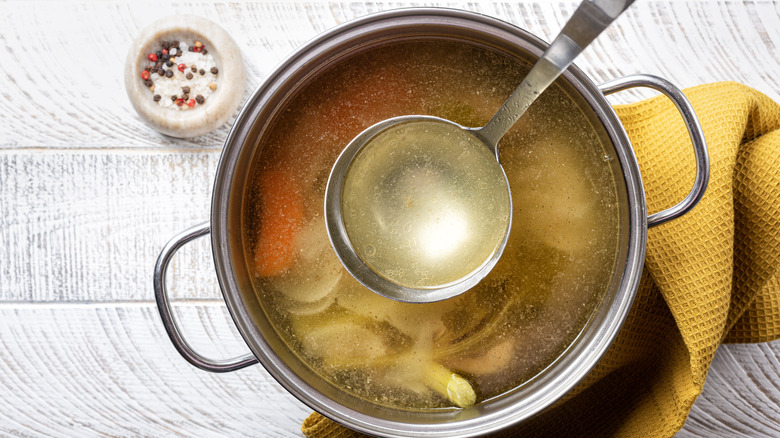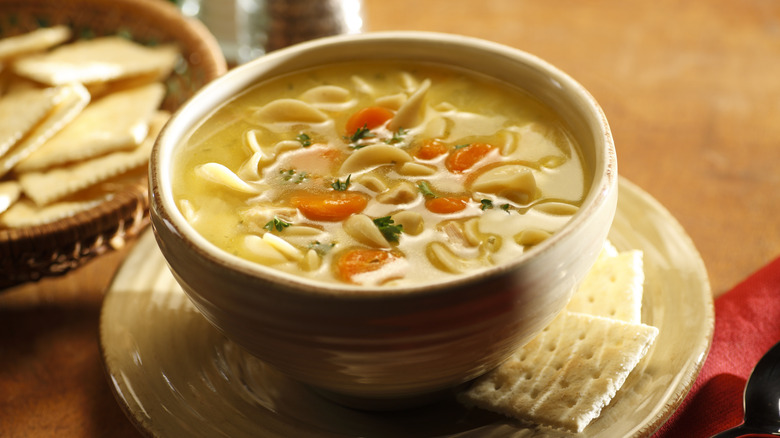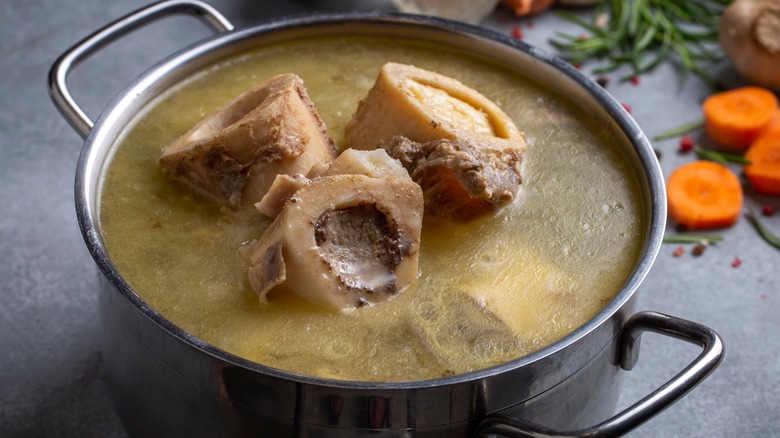Broth Vs Stock: When To Use Each In Your Cooking
If you're a regular home cook, chances are you have a carton of stock or broth lying around — you may even have both. In our modern world, many people opt to buy cooking liquids like these rather than spend hours standing over a hot stove to make them, which is completely reasonable. However, always opting for premade broth or stock can make it easy to forget what exactly goes inside which liquid, and how that makes the two different. Cooking with either broth or stock is a quick and simple way to add depth to any dish, but that doesn't necessarily mean they should be used interchangeably. Due to each liquid's different ingredients, broth and stock have different flavors and consistencies.
In general, broth is lighter and made by simmering meat, while stock is richer and made by simmering bones. Most people add vegetables to both broth and stock to give it a bit more flavor. Cooking animal bones in stock extracts gelatin, which makes homemade stock more viscous (vegetable stock usually has plant-based gelatin added in). This texture difference is subtle, and while you can usually substitute one cooking liquid for the other in a pinch, it can make a big difference in your recipes.
Broth is for lighter fare
Perhaps the key difference between broth and stock is that broth can be enjoyed as a standalone soup. As good as it is on its own, it's also perfect for lighter dishes where you want a clear, delicate foundation. You can use broth as a base for soups, like chicken noodle or vegetable soup, or use it to cook other dishes like mashed potatoes. You can make practically anything into a stock. For example, to make lohikeitto, a soup from Finland, you make a stock using salmon.
Making broth at home is a shorter process than making stock, but it still requires some patience. Start by simmering meat and aromatics like garlic, celery, and onions in a large pot. From here, how you season it depends on what you're planning to do with it. If you're using it as a base for something else, just add some salt and pepper. Or, if you want to enjoy it by itself, play around with different herbs and spices to nail your perfect broth recipe. After about 90 minutes, you'll want to scoop out any impurities before sitting down to enjoy.
In your cooking liquid journey you may have heard of bouillon. Bouillon cubes are condensed blocks of powder that contain salt, sugar, protein, and various meat extracts like chicken, beef, and shrimp. These pungent little cubes are a quick way to get a broth going, or to give an already-existing broth a bit more flavor.
Stock is more hearty
Alternatively, stock is usually intended to serve as a base for other ingredients, so it's left unseasoned. This way, it can thicken up a dish without an overwhelming flavor profile. People use stock as a base for everything from hearty beef stew to decadent gravy to delicate risotto. You can use stock to cook your pasta too! Stock is also ideal for making sauces, such as the classic French sauce velouté. This creamy sauce is a great example of how the richness of stock can support other culinary creations.
If you want to make stock at home, you'll have to block out your whole afternoon, but it will be worth it. Start by simmering animal bones in water for several hours, if not more; some people like to sear whatever meat is left on the bones beforehand, but it's not necessary. Add in your aromatics, but don't add in any seasoning so the stock maintains its neutral flavor.
Bone broth, a variant of stock, is made by roasting bones before simmering them for a full 24 hours. The idea is that since the bones cook for such a long time, more nutrients are extracted from them. Therefore, the resulting broth is extra infused with vitamins and minerals. It's not currently clear if bone broth is the super food we've been waiting for, but there's no doubt that any type of broth or stock contributes to a healthy and filling meal.


